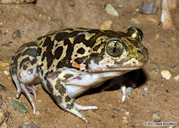|
Description
Tympanic membrane absent. Skin smooth. Sternum ossified. Pupil of the eye is vertical. Webs between the toes well-developed. Inner metatarsal tubercle of the hind foot quite large and spade-shaped. No male resonators. Body robust, hind legs short, head large. In average, this species is larger than Common Spadefoot (Pelobates fuscus). In contrast to the latter species, the vomerine tooth series is longer and divided with narrower gap. Inner metatarsal tubercle very large, yellowish in color. Web between the toes possess large cuts. Frontal area between the eyes is not prominent. Dorsal coloration yellowish or gray with large dark-greenish spots. Ventral surface white-grayish, without pattern.
Distribution and Habitat
Country distribution from AmphibiaWeb's database: Armenia, Azerbaijan, Bulgaria, Georgia, Greece, Iran, Islamic Republic of, Iraq, Israel, Lebanon, Russian Federation, Syrian Arab Republic, Turkey
The Eastern Spadefoot Toad lives in the Balkan Peninsula eastwards to the Black Sea, as well as in Northern Syria, Palestine, Northern Israel, Northern Iraq, Caspian Iran, Asia Minor and the Caucasus. The distribution needs further study.
This species lives in forested, steppe and semi-desert areas in foothills and mountain valleys. It probably avoids the forest belt and is distributed in open landscapes, and appear to be less selective than P. fuscus in terms of soil preference. It inhabits not only soft soils suitable for a fossorial life (although they are preferred), but also solid, rocky soils, in particular more or less friable clay with pebbles.
Life History, Abundance, Activity, and Special Behaviors
The overall population numbers appear to be low due to patchy distribution of this species. However, local density reaches 5-7 adults per 4000-5000 m2. Pelobates syriacus is active at night and displays nightly site-fidelity. The burrows are made in the same manner as the Common Spadefoot burrows. The species also uses rodent burrows and holes under stones. In steppes and semideserts, where the summer air temperatures sometimes exceed +40ºC, the spadefoot occurs in deep holes with water, along riverbanks and in oases. It probably spends hot and dry periods in the soil, i.e. aestivation is possible. Droughts lead to mass mortality, which may influence population abundance.
Eastern Spadefoots hibernate in soil, in plant debris, and below tree roots and large rocks. As a rule, they hibernate singly, but sometimes groups of 2-6 individuals are found. Reproduction occurs from February to mid-May, depending on latitude. The toad breeds in stagnant water bodies. During the reproductive period, the male shoulder gland becomes more prominent. The clutch contains about 5500-6500 eggs and is similar in shape to the clutch of P. fuscus. Metamorphosis is completed in summer or in autumn. Many toadlets bury themselves on the pond shores. In some water bodies tadpoles overwinter and complete metamorphosis the following year. Tadpoles consume mainly algae and plant debris. Adults forage on land surface dwellers, including Mollusca, Myriapoda, Aranae, Orthoptera etc.
Trends and Threats
Not studied.
Relation to Humans
Evidently, drainage of breeding ponds and the building of embankments may have negative consequences for its populations. The species does not avoid anthropogenic landscapes if suitable habitats are available.
Possible reasons for amphibian decline Drainage of habitat
References
Bannikov, A. G., Darevsky, I. S. and Rustamov, A. K. (1971). Zemnovodnye i Presmykayushchienya SSSR [Amphibians and Reptiles of the USSR]. Izdatelistvo Misl, Moscow.
Bannikov, A. G., Darevsky, I. S., Ishchenko, V. G., Rustamov, A. K., and Szczerbak, N. N. (1977). Opredelitel Zemnovodnykh i Presmykayushchikhsya Fauny SSSR [Guide to Amphibians and Reptiles of the USSR Fauna]. Prosveshchenie, Moscow.
Basoglu, M. and Ozeti, N. (1973). Turkiye Amphibileri. Ege Univ, Bornova-Izmir.
Gasc, J. P. , Cabela, A., Crnobrnja-Isailovic, J., Dolmen, D., Grossenbacher,K., Haffner, P., Lescure, J., Martens, H., Martinez Rica, J. P.,Maurin, H., Oliveira, M. E., Sofianidou, T. S., Vaith, M., and Zuiderwijk, A. (1997). Atlas of Amphibians and Reptiles in Europe. Societas Europaea Herpetologica and Muséum National d’Histoire Naturelle, Paris.
Kuzmin, S. L. (1995). Die Amphibien Russlands und angrenzender Gebiete. Westarp Wissenschaften, Magdeburg.
Kuzmin, S. L. (1999). The Amphibians of the Former Soviet Union. Pensoft, Sofia-Moscow.
Leviton, A. E., Anderson, S. C., Adler, K. and Minton S. A. (1992). Handbook to Middle East Amphibians and Reptiles. Society for the Study of Amphibians and Reptiles, Oxford, Ohio.
Nöllert, A. and Nöllert, C. (1992). Die Amphibien Europas. Franckh-Kosmos Verlags-GmbH and Company, Stuttgart.
Tarkhnishvili, D. N. and Gokhelashvili, R. K. (1999). ''The amphibians of the Caucasus.'' Advances in Amphibian Research in the Former Soviet Union, 4, 1-233.
Terent'ev, P. V. and Chernov, S. A (1965). Key to Amphibians and Reptiles [of the USSR]. Israel Program for Scientific Translations, Jerusalem.
Originally submitted by: Sergius L. Kuzmin (first posted 1999-10-06)
Edited by: Meredith J. Mahoney (2021-01-26)Species Account Citation: AmphibiaWeb 2021 Pelobates syriacus: Eastern Spadefoot <https://amphibiaweb.org/species/5271> University of California, Berkeley, CA, USA. Accessed Mar 28, 2025.
Feedback or comments about this page.
Citation: AmphibiaWeb. 2025. <https://amphibiaweb.org> University of California, Berkeley, CA, USA. Accessed 28 Mar 2025.
AmphibiaWeb's policy on data use.
|
